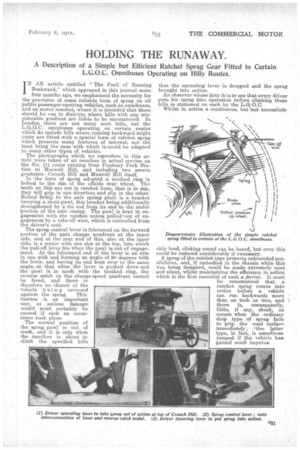HOLDING THE RUNAWAY.
Page 21

If you've noticed an error in this article please click here to report it so we can fix it.
A Description of a Simple but Efficient Ratchet Sprag Gear Fitted to Certain L.G.O.C. Omnibuses Operating on Hilly Routes.
IN AN article entitled "The Peril of Running Backward," which appeared in this journal some four months ago, we emphasized the necessity for the -provision of some reliable form of sprag on all public passenger-carrying vehicles, such as omnibuses., and on motor coaches, where it is intended that these should be run in districts where hills with any oonsiderable gradient are liable to be encountered. In London there are not many such hills,. but the L.G.0.0. omnibuses operating on certain routes which do include hills where running backward might occur are fitted with a special form of ratchet sprag which presents many features of interest, not the least being the ease with which it#could be adapted to many other types of vehicles.
The photographs which we reproduce in this article were taken of an omnibus in actual service on the No. 111 route running from Finsbury Park Station to Muewell Hill, and including two severe gradients—Crouch Hill and Muswell Hill itself. In the form of sprag adopted a toothed ring is bolted to the rim of the offside rear wheel. The teeth on this are cut in ratchet form, that is to say, they will grip in one direction and slip in the other. Bolted firmly to the axle spring plate is a bracket carrying a stout pawl, this bracket being additionally Strengthened by a tie rod from its end to the under 'portion of the axle casing. The pawl is kept in engagement with the ratchet imless pulled•out of engagement by a take-off wire, which is controlled from the driver's seat.
The sprag control lever is fulcrumed on the forward portion of the gate change quadrant at the inner side, and at the rear end of this, also at the inner side, is a sector with one slot at the top, into which the pull-off lever fits when the pawl is, out of engagement. At the fulerumecl end of the lever is, an arm in one with and forming an angle of 90 degrees with the lever, and having its end bent over to the same angle, so that when the lever is pushed down and the pawl is in mesh with the toothed. ring, the reverse catch on the change-speed quadrant cannot be freed, and there is therefore no chance of the vehicle b eing reversed against the sprag, This featere is an important onek,' as seiious damage would most certainly be caused if such an occurrence took place.
The normal position of the sprag pawl is out of mesh, and it is only when the omnibus is about to climb the specified hills that the operating lever is dropped and the sprag brought into action.
An observer whose duty it is to see that every driver puts his sprag into operation before climbing these hills is stationed on each by the L.G.O.C.
Whilst in action a continuous., but not ancorafort,
ably loud, clicking sound can be heard, but even this could be reduced considerably if necessary.
A sprag of the ratchet type presents unbounded possibilities, and, if embodied in the chassis while this was being designed, could be made extremely neat and silent, whilst maintaining the efficiency in action which is the first essential of such a device. It must be remembered that a ratchet 'sprag comes intoaction before a vehicle can run backwards more than an cinch or two, and there is, 'consequently, little, if any, shocks as occurs when the ordinary drop type .of sprag fails to grip the road surface immediately, the latter type, in fact, is sometimes jumped if the vehicle has gained much impetus.






























